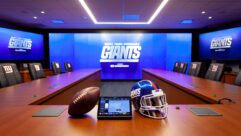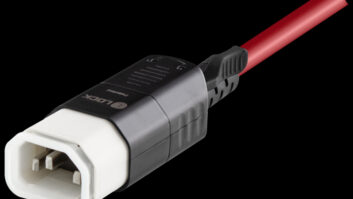ERIK INDRESOVDE
DIRECTOR OF AV PRODUCTS, BLACK BOX
Today’s IP based AV solutions can be divided into two groups: the proprietary LAN based video systems and the open H.264 based streaming solutions. The closed systems can be easier to set up and provide additional features, but the downside is that these solutions require massive bandwidth and only work within their own ecosystem. The H.264 based solutions are inter-operable, but they are often separate decoder and encoder devices. Even if H.264 is a standard, integrating it into other platforms for decoding or distribution isn’t always that easy. The next step is a complete video distribution system with built in support for other platforms and services for easy sharing of video to any device across the world.
JASON FITZGERALD
PRODUCT MANAGER, GEFEN
The next frontier in AV signal management will be the development of a copper-based extension solution to accommodate the full bandwidth of the HDMI 2.0a signal standard. The market currently offers splitters, switchers, and matrix products with HDMI 2.0a capability, but a product that enables the extension of HDMI 2.0a over a copper-based category cable does not yet exist. The creation of this product using a single-cable solution is an inevitable next step for the industry. This will require cutting-edge compression methods (such as the use of DSC, Display Stream Compression) to transmit the signal in a way that is visually lossless.
AJ SHELAT
VP OF SALES, HALL RESEARCH
Recent improvements in technology now allow transport of video with resolution of up to UHD/4K at 60Hz with 4:4:4 chroma over IP. The addition of USB communications has opened new possibilities and applications for the video over IP platform. Other recent innovations in this technology have now made video wall implementation very flexible. One of the newer features that some systems show come from more intuitive graphical user interfaces for system-level control and configuration. Similarly, the ability to store and recall presets or manipulate a user-defined group of endpoints brings further benefits. Overall advancements in video over IP will provide a simpler and more costeffective installation and a better user experience.
DAN HOLLAND
MARKETING MANAGER, IHSE USA
Today’s system designers for AV signal management are going through a transition to eliminate the traditional stove-piped communications concept to a more open-source infrastructure. The ability to obtain, gather, process, and distribute information effectively is key to gaining operational superiority, and many system designers have found KVM switching to be an effective means to streamline data access while maintaining an important level of security and data quality. At IHSE, we are bringing new compression technologies based on the Fraunhofer IIS lightweight image coding technology (lici) to bring higher color accuracy and improved image quality to overcome the limitations that were normally found in traditional compressed video techniques. Another key benefit to workflow efficiency is mouse sharing over multiple displays.
KASHYAP KHETIA
PRODUCT MARKETING MANAGER, KANEXPRO
There’s a growing number of modern workers requiring access to anytime, anyplace collaboration. In today’s workplace, design trends are shifting toward flex-use spaces maximizing the utilization of space, and huddle rooms versus the traditional office. Contemporary workplace priorities are tailored to the rise of remote and virtual employees in today’s workforce requiring virtualization, cloud computing, cloud content sharing, and telepresence in an environment where users can share, collaborate, and present projects on a digital canvas. It’s becoming essential to have reliable products with high-quality signal management, and we believe the importance of signal management will only continue to grow over the next few years.
TOMMY KOPIN
GLOBAL ENGINEERING SPECIALIST, KRAMER
“What’s next” is a combination of faster IT networks (with an increasing number of them using optical fiber) and low-latency codecs to distribute audio, video, and control signals with light compression. Motion JPEG2000 (M-JPEG 2K) is emerging as the favored codec format for this application, as the AV industry continues its methodical transition to IT-based signal management infrastructure. With 10Gbps network switches widely available at competitive prices, it’s now possible to stream Ultra HD video and multichannel audio to multiple points with real-time (RTTP) protocols and IP headers. For even more efficient transmission where latency isn’t an issue, H.264 AVC and the new H.265 codec will enable multiple, simultaneous streams of Full HD and 4K video on a single fiber.
JIM KOSMERICK
DIRECTOR OF MARKETING, LIGHTWARE USA
The transition away from Full HD AV to strictly 4K and beyond is well underway. While there are abundant choices for 4K displays and 4K content, the biggest remaining challenge for AV professionals is to build 4K signal management infrastructures that have sufficient bandwidth to transport, switch, and distribute 4K signals and beyond. 4K signal management products that are truly 4K 60Hz 4:4:4 are gaining traction for future-proof solutions.
PETER MACOUREK
GENERAL PARTNER, ROSE ELECTRONICS
There are a lot of different low-latency protocols for sending video, audio, and data over networks. The security industry has prospered with IP cameras. These use very standard protocols such as RTSP (real time streaming protocol) or motion JPEG. Other common streaming protocols such as HLS or RTMP allow better routing capabilities, but they may add latency. Other protocols for sending AV data are screen oriented, such as RDP (remote desktop protocol) or those used for conferencing applications such as Citrix’s GoToMeeting or Cisco’s WebEx. Then there’s voice over IP, which can have video too and includes products such as Apple’s FaceTime. When it comes to KVM interaction, VNC is one of the few standard protocols. The latest HEVC video codec has promise for low latency, but I’ve yet to see anyone who has implemented the H.265 screen content coding extensions needed to show crisp text. While some of these protocols have different use cases, there is a huge overlap and many are proprietary. The industry is ripe for some real-time, non-proprietary AV networking standards.
STEPHEN D. METZGER
V.P. HARDWARE AND OPERATIONS, ZEEVEE
We see the transition to high-bandwidth, standards-based, IP distribution over Ethernet becoming the dominant method of AV distribution. There is really no longer a need for older technology, which is closed, and often proprietary. Newer technologies on the market today allow for the distribution of HD-Ultra HD/ 4K and HDR content over a standard 1G or 10G network without bandwidth limitations, and at a much lower cost. With plug-and-play technology, intuitive switching, and control applications, end users deploying such solutions will significantly reduce costs of cabling, equipment, programming, management, and maintenance. Suppliers that offer IP distribution systems that make it easy for customers will win.










